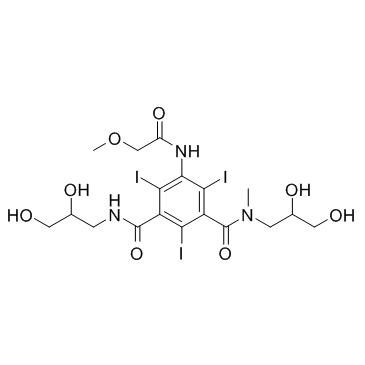iopromide

iopromide structure
|
Common Name | iopromide | ||
|---|---|---|---|---|
| CAS Number | 73334-07-3 | Molecular Weight | 791.112 | |
| Density | 2.2±0.1 g/cm3 | Boiling Point | 840.9±65.0 °C at 760 mmHg | |
| Molecular Formula | C18H24I3N3O8 | Melting Point | broad (160ºC transition) | |
| MSDS | USA | Flash Point | 462.4±34.3 °C | |
| Symbol |

GHS09 |
Signal Word | Warning | |
|
Adverse skin reactions to iodinated x-ray contrast agents in healthy rats.
Invest. Radiol. 49(12) , 779-87, (2014) The aim of this preclinical study on healthy Sprague-Dawley rats was to determine whether differences exist in the induction of adverse skin reactions after the intravenous administration of a monomeric and 2 dimeric iodinated nonionic contrast agents.After i... |
|
|
Analysis of the roles of glucose transporter 1 and hexokinase 2 in the metabolism of glucose by extrahepatic bile duct cancer cells.
Clin. Nucl. Med. 40(3) , e178-82, (2015) Extrahepatic bile duct (EHD) cancer varies in uptake of FDG. The aim of the present study was to determine the role of glucose transporter (GLUT) 1 and hexokinase (HK) 2 in the glucose metabolism of EHD cancer cells using immunohistochemistry and 18F-FDG PET/... |
|
|
Ventilation/perfusion mismatch during lung aeration at birth.
J. Appl. Physiol. 117(5) , 535-43, (2014) At birth, the transition to newborn life is triggered by lung aeration, which stimulates a large increase in pulmonary blood flow (PBF). Current theories predict that the increase in PBF is spatially related to ventilated lung regions as they aerate after bir... |
|
|
Co-metabolic oxidation of pharmaceutical compounds by a nitrifying bacterial enrichment.
Bioresour. Technol. 167 , 336-42, (2014) The biotransformation of five selected pharmaceuticals ibuprofen (IBP), ketoprofen (KTP), carbamazepine (CBZ), dexamethasone (DXM) and iopromide (IOP) by a stable nitrifying enrichment culture was investigated at concentrations ranging between 25 μg/L and 2mg... |
|
|
Early postoperative 18F-FDG PET/CT in high-risk stage III colorectal cancer.
Clin. Nucl. Med. 40(4) , e222-7, (2015) PET/CT may contribute to staging modification in different phases of colorectal cancer (CRC) management. However, it is not routinely indicated for stage III CRC. This study sought to determine the role of early postoperative PET/CT in patients with high-risk... |
|
|
Frequency, CT findings, and fate of multiple infarcted regenerative nodules in liver cirrhosis after variceal bleeding or septic shock.
Abdom. Imaging 40(4) , 835-42, (2015) To evaluate the frequency, CT findings, and fate of multiple infarcted regenerative nodules in patients with liver cirrhosis after variceal bleeding or septic shock.During a recent 3-year period, 492 patients with hematemesis or melena (n = 445) and septic sh... |
|
|
Intermodel agreement of myocardial blood flow estimation from stress-rest myocardial perfusion magnetic resonance imaging in patients with coronary artery disease.
Invest. Radiol. 50(4) , 275-82, (2015) The aim of this study was to assess the intermodel agreement of different magnetic resonance myocardial perfusion models and evaluate their correspondence to stenosis diameter.In total, 260 myocardial segments were analyzed from rest and adenosine stress firs... |
|
|
Advanced adenocarcinoma of the lung: comparison of CT characteristics of patients with anaplastic lymphoma kinase gene rearrangement and those with epidermal growth factor receptor mutation.
Radiology 275(1) , 272-9, (2015) To study the differences in computed tomographic (CT) characteristics between patients with advanced lung adenocarcinoma who have anaplastic lymphoma kinase (ALK) gene rearrangement and those who have epidermal growth factor receptor (EGFR) mutations.This ret... |
|
|
Optimizing contrast media injection protocols in state-of-the art computed tomographic angiography.
Invest. Radiol. 50(3) , 161-7, (2015) Very short acquisition times and the increasing use of low-kilovolt protocols in standard computed tomographic (CT) angiography (CTA) examinations demand modifications in the contrast media (CM) injection regimen. The aim of this study was to optimize the use... |
|
|
Peripheral nervous system origin of phantom limb pain.
Pain 155(7) , 1384-91, (2014) Nearly all amputees continue to feel their missing limb as if it still existed, and many experience chronic phantom limb pain (PLP). What is the origin of these sensations? There is currently a broad consensus among investigators that PLP is a top-down phenom... |